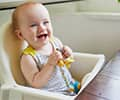Can Babies With Cleft Lip Breastfeed?
Children born with a cleft palate may have difficulty breastfeeding because their connection with the breast may be weak or they may not produce enough suction, as the Children's Hospital Colorado explains. Because of the physical split in their palate, milk or formula may also leak through their nostrils, causing them to take in fewer nutrients. However, though latching may prove difficult for babies with a cleft lip, many can breastfeed normally. The size of the cleft in the lip impacts how well a baby can create the suction needed to feed.
How Do You Breastfeed a Baby With a Cleft Lip and Palate?
According to the Cleft Lip & Palate Association (CLAPA), there are several steps you can take to guide your baby to breastfeed successfully:
- Work with a breastfeeding specialist on positioning for the best suction for success.
- Determine with a specialist when your child is "dummy sucking" — when they're latched but now swallowing — and when they're able to suck and swallow.
- Use a nipple shield with a larger or different hole shape for better support.
Only rarely do doctors advise placing a feeding plate directly into your child's mouth. The plate acts as a vacuum to better enable your child to suck and breastfeed in these cases. That said, there are varying opinions in the medical community about the use of these plates. They could possibly use them to start guiding the cleft to close before surgery, but these plates are not common. You'll want to discuss this option with your doctor and seek a specialist's advice.
Not all babies can breastfeed, but they can still get the nutrients they need. Per the CLAPA, depending on the size and position of the cleft, you may be able to use a bottle with a scoop or uniquely shaped nipple. On occasion, some may need to use feeding tubes.
Oral Hygiene and Cleft Palate or Lip
Maintaining your baby's oral hygiene is crucial. As the CLAPA notes, babies do not produce much saliva in the first one to two months of life. Therefore, it's important to wipe their mouth with a soft, clean cloth after feeding, taking special care of the sensitive tissue and area around the split.
For children with a cleft palate or lip, teeth can erupt crooked or sideways, making it more challenging to keep the areas clean. They are also more prone to bacteria build-up and tooth decay. Work with your dental professional to create the best oral care plan. Ask them about any specific cleaning tools you can include in your child's daily oral care regimen.
Breastfeeding a child with cleft palate or lip may be possible with certain techniques, or you may try alternate modes of feeding. Whether by breast, bottle, or tube, you can take comfort knowing that there are many options to keep your child well fed.
Oral Care Center articles are reviewed by an oral health medical professional. This information is for educational purposes only. This content is not intended to be a substitute for professional medical advice, diagnosis or treatment. Always seek the advice of your dentist, physician or other qualified healthcare provider.
ORAL HEALTH QUIZ
What's behind your smile?
Take our Oral Health assessment to get the most from your oral care routine
ORAL HEALTH QUIZ
What's behind your smile?
Take our Oral Health assessment to get the most from your oral care routine
Join Us
Get the best of your oral health routine and take it to the next level with expert advice, recommendations, products and solutions and special offers.
Join Us
Get the best of your oral health routine and take it to the next level with expert advice, recommendations, products and solutions and special offers.















